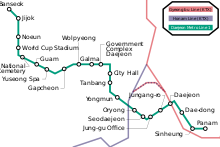Daejeon Metro
The Daejeon Metro is a rail-based public transport system in the South Korean city of Daejeon , which is the fifth largest city in the country with a population of 1.5 million. The subway consists of one line and, together with the bus system, forms the backbone of local public transport in the city.
| line 1 | |||||||||||||||||||||||||||||||||||||||||||||||||||||||||||||||||||||||||||||||||||||||||||||||||||||||||
|---|---|---|---|---|---|---|---|---|---|---|---|---|---|---|---|---|---|---|---|---|---|---|---|---|---|---|---|---|---|---|---|---|---|---|---|---|---|---|---|---|---|---|---|---|---|---|---|---|---|---|---|---|---|---|---|---|---|---|---|---|---|---|---|---|---|---|---|---|---|---|---|---|---|---|---|---|---|---|---|---|---|---|---|---|---|---|---|---|---|---|---|---|---|---|---|---|---|---|---|---|---|---|---|---|---|
|
|||||||||||||||||||||||||||||||||||||||||||||||||||||||||||||||||||||||||||||||||||||||||||||||||||||||||
history
The first underground line opened on March 16, 2006. It ran from Panam Station in the east of the city to the Government Complex in a newly built district of Seo-gu near the Grapcheon River.
On April 17, 2007, the second section went into operation. He extended the existing route in a north-westerly direction to Banseok station.
The line was originally planned to be completed for the 2002 World Cup in Korea and Japan. However, that did not happen.
course
The route of line 1 is a total of 22.6 km long and begins in the southeast of the city at the Panam station. From there it continues westwards via Daejon Station , where it is connected to the mainline Korean railway network. It then traverses the older districts of Daejon before turning north into the newer districts and heading for the City Hall and Government Complex stations , which is the seat of the region's central government. There it bends to the west and reaches another traffic junction with the Guam station, where there is a connection to the intercity bus terminal. Shortly after the route changes its course again to the north, it reaches the Worldcup Stadium station , before reaching the north-western end of the city with the Banseok station.
Planning
The city's plan provides for a total of five lines:
Line 2 should be 30.5 km long, run as a ring around the city and above all connect the southwest of the city, which is currently being developed with further residential areas, with the districts north of the Grapcheon River. She would cross Line 1 at Daejeon Station, Seodaejeon Negeori, and Yuseong Spa.
Lines 3 and 4 would each represent north-south connections, with Line 3 to run parallel to the Gyeongbuseon Railroad .
Line 5 should represent an east-west connection. The implementation is uncertain.
Depots
Depots are located at the end of Line 1 in the south-east and north-west of the city.
Daejeon magnetic levitation train
The maglev of Daejeon was opened in 1993 for the World Expo in Daejeon. It runs from the Expo site, which is now called Science Park, to the National Science Museum and is just under a kilometer long. The vehicle comes from the Korean company Rotem.
Web links
- Official operator website (Korean / English)
- Urbanrail.net (english)
- Video of the maglev train
Individual evidence
- ↑ www.urbanrail.net (English)
- ↑ DAEJEON Subway (Taejon, South Korea) - urbanrail.net (English)
